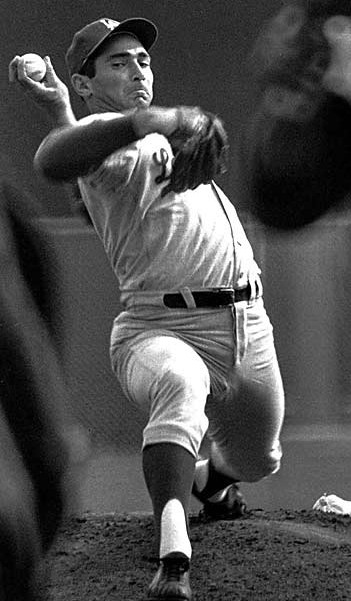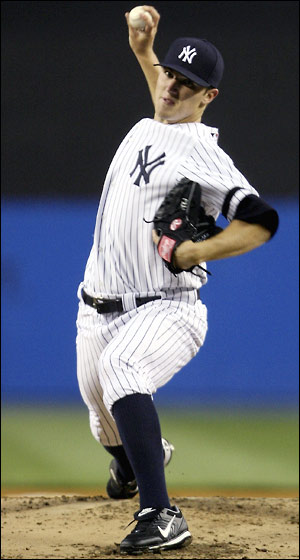ESPN's Buster Olney writes, at the beginning of a 2,800-word "blog post", that Rockies closer Huston Street has experienced dramatic improvement due to the smallest of changes:
...Bob Apodaca, the Colorado pitching coach, approached him and told him he wanted to make a rather major alteration. "We'd like you to move to a different part of the [pitching] rubber," Apodaca said.*Editor's note: Actually it was 2.22. I'm just sayin'.Street didn't buy it. Not then, anyway. But after a mediocre spring training, and after he allowed four runs in his first four relief appearances in the regular season, Street had an open mind. He shifted from the left side to the right side of the rubber, and after he had done it for a short time and saw what the change did for him, he couldn't even imagine moving back to the left. "I don't know why things work out the way that they do," Street mused Sunday, "but they do."
Since those first four outings, Street has excelled, posting a 2.33* ERA, converting saves in 15 of 16 chances. He is 8-for-8 this month as the Rockies have made their push back from deep in the NL West standings to over .500, capped by Street's picking up the save Sunday, closing out the Pirates.

Articles like this one always make me laugh, about how changing from one side of the pitching rubber to the other made someone a better pitcher, or how an offseason training regimen or starting to jog everyday or eat more granola or something made some former star a better player again. Usually it's just normal statistical fluctuation, but of course sportwriters can't write about that because
A) it's boring and
2) ZZZZZzzzzzzz......
So they talk to the pitcher, who probably has never taken a statistics class, or a physiology class or a physics class, for that matter, and he explains to them that this and that is the reason for his sudden success. This is much more interesting, or at least less sleep-inducing, than Chi-square distributions and bell curves and standard deviations and all that rot, and anyway, by next week nobody will remember what he said or what Buster wrote because they'll have moved on.
Olney's explanation for the improvement is as follows:
When throwing on the left side of the rubber, Street could throw strikes against left-handed batters by running a fastball over the outside corner, no matter how flat it was -- and the ball would have to travel a longer distance from his hand to the corner. But once Street was on the right-hand part of the rubber, it forced him to be more disciplined in his mechanics. He'd have to get on top of the ball properly to throw it for strikes to the outside corner to lefties, and inside to right-handers. If he didn't throw the ball correctly, it would drift off the plate.
"I've got more of the sinking action than the running action," Street said.
In case you're wondering, the difference in the distance to one side of the plate from one side of the pitching rubber or the other is, at most, about 0.4".
Four-tenths of one inch.
Or, as they say in France, "almost nothing".
It's a simple geometry problem, with a right triangle, 60.5 feet on one side and two feet (the width of the pitching rubber) on the other. The hypotenuse of that triangle is therefore 60.53 feet, or 60 feet, 6.4 inches. That 0.4" difference represents an increase of 0.7% compared to throwing from the other side of the rubber. No wonder Street's been so fatigued!
Street really was quite terrible in those first four games of the season, or at least in three of them. In mid-April, having pitched only four times in the team's first eight games, Street had an 0-1 record with one Save and a 13.50 ERA. Then he supposedly made this change, and over the next four games he was...
...still pretty lousy.
No Wins or Losses, but no Saves either and only one Hold, to go with a 5.79 ERA in those games, though he struck out six and walked none in 4.2 innings. The real improvement followed that. From April 26th to June 21st, he had 15 Saves, two wins and no losses, 27 K's and eight walks in 23.2 innings, to go with a sparkling 1.52 ERA.
The real improvement was not in the walks, as Olney's "analysis" (or shall we say, "Olnalysis"?) suggests it would be. In the first eight games of the season, Street issued only one walk in 7.1 innings. After that, Street's walk rate more than doubled, from 1.23 per nine innings to 3.08 per nine.
The real problem was that he allowed three homers and three doubles in those first seven innings and change, while in the 23.2 innings after that he allowed three extra base hits total (two homers and a double).
Technically, if he's getting more sink on the ball, this would be one result, and so maybe it is helping. But if so, it's because he's being more consistent with his mechanics, not because of which side of the rubber he stands on before he winds up to throw. He could have done this from either side of the rubber if he'd just been diligent about his mechanics.
Looking at this from the other perspective, if Street now has to force himself to "get on top of the ball" more because he can't throw a strike to the outside corner otherwise, shouldn't he now be susceptible to having the ball run back over the middle of the plate when he's trying to throw inside to lefties? If he gets lazy or fatigued and doesn't get the proper sink on the ball, now he's susceptible to allowing doubles and homers, rather than walks. And yet, just the opposite has happened, he's allowed fewer extra base hits, but more walks.
It still comes down to making sure his mechanics are maintained properly, which he can (theoretically) do from either side of the rubber. The real reason for his marked improvement, I think, is that the Rockies' level of competition has changed drastically from that first three weeks of the season. Street faced the Dodgers and Phillies, ranked #1 and #2 in the National League in Run scoring, in six of his first nine games, and his ERA took a beating for it.
Of the 24 games since, 12 have come against teams in the bottom half of the majors in run scoring, and among those, San Diego, Houston, and Seattle are three of the five worst teams in baseball at scoring runs. To me that makes a lot more sense than four tenths of an inch difference causing Huston Street to finally get his mechanics straightened out, and this after having been pretty darned successful in the first 247 games of his major league career.
Olney closes that portion of the blog post this way:
Street cited something that Troy Tulowitzki said recently -- that the Rockies are beginning to expect good things to happen. "You don't know whether success creates that mentality, or whether that mentality creates success," Street said. "I think it's a little bit of both."Look, pal, that's just plain lazy.
When I was in college, I spent a lot of time studying the Bible with friends from my InterVarsity Christian Fellowship group, using something they called the "inductive method" of study, which essentially seeks to determine what the original author meant to convey to his or her original audience. In a group of 10 or 15 students or more, we would discuss one small section at a time, say, 10-15 verses of the Gospel of Mark, and inevitably, at least once per session, we would come to some kind of impasse.
One student would suggest that Mark was trying to say this, and another would suggest he was trying to say that, the interpretations being mutually exclusive, of course. And after a while, someone would suggest that, "Maybe it's a little bit of both!" This happened so often and so consistently that we coined a term for it: "The Relativistic Third Option." Sometimes, it might have been the best way to interpret something, as certain passages can be interpreted in several ways, none of which is inherently inconsistent with the rest of scripture.
But usually we were just being lazy. It's often hard work to figure out which of two mutually exclusive options is the correct one, and in this world of post-modern ideas and tolerance and relativism, people are too often satisfied with wuss-out explanations like, "It's a little bit of both."
Either your "winning mentality" put you in a position to help make good things happen, or you got lucky, started to win and then tried to think about what else you could do to help the team win more. There is no such thing as "a little bit of both" in this case.
Why doesn't anybody ever just say, "I don't have any idea"?

















